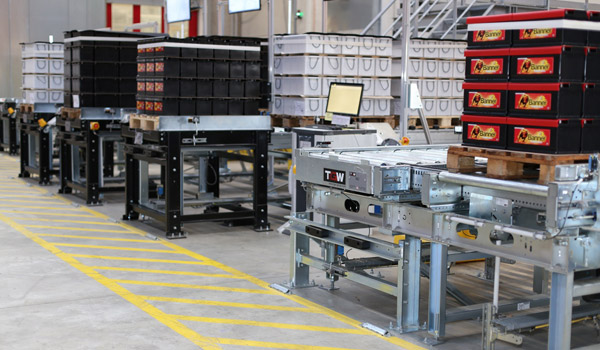
To accommodate an additional 10,000 vehicle starter batteries, battery manufacturer Banner has expanded its warehouse in Linz, Austria, using the latest automated technologies from TGW.
Banner is internationally recognised as a leading battery producer, supplying major automotive manufacturers such as Audi, BMW, VW, Porsche and Mercedes with batteries for first fitting. Headquartered in Linz, Upper Austria, Banner generated a turnover of 239 million Euros in the business year 2014/2015, selling in the region of 3.8 million starter batteries per year.
Banner’s continuous growth called for a considerable increase in warehouse capacity as well as performance. To be prepared for the future, Banner built a new warehouse area as well as an automated warehouse and workstation area in the existing hall. Here, semi-finished batteries without fluid are stored for further intra-company processing, as well as filled batteries ready for despatch to customers.
Thomas Bawart, Technical Managing Director of Banner Batterien, believes the high-bay warehouse to be a key element for future growth: "Our primary objective is to remain a sustainable and economically sound business. An increase in production quantities has to be consistent with increases in productivity and efficiency."
Achieving full power
Banner’s factory premises in Linz-Leonding were expanded with the aim of increasing the capacity of the pallet storage locations by 10,000 positions. On average, 22 pallets per hour will be stored and 33 pallets retrieved. At peak times, this will rise to between 66 and 90.
Working with these targets and in close collaboration with Banner, TGW devised a sophisticated intralogistics solution for production and supply.
The new high-bay warehouse consists of TGW’s fully automated storage and retrieval machines that operate in an oxygen-deficient environment containing more than 10,000 pallet storage locations. Additional pallets are stored in three double-deep warehouse aisles, which means that pallets are always stored one behind the other. To allow for future growth, further expansion of the warehouse with additional aisles was also taken into consideration during the planning phase.
To maintain the reduced oxygen levels in the warehousing area, pallets are transported through four locks including fire doors to the transfer car, which carries them to three outbound stations and/or two inbound stations with a corresponding number of buffer locations. Additionally, the inbound stations are equipped with profile checks and a weight check up to maximum of 1,500kg.
Supply and clearance of the workstations is either affected by manual lift truck operation or by the existing driverless transport system (DTS), which transports the pallets with the batteries automatically to the individual destinations.
Multipurpose software
All internal production lines are supplied with ‘green’, i. e. unfilled batteries, from the high-bay warehouse. Storage of the green batteries at both inbound stations is realised via the driverless transport system or lift trucks. Single-item pallets are stored exclusively. For storage, a balanced distribution of the items with reference to stock across all possible aisles is taken into consideration. If an aisle is not available, the operation will nevertheless be ensured.
Six production lines will be supplied according to the production orders generated by the host system. The inbound order, which the host system transmits to TGW’s Commander software lists the entire quantity of the order, which will then be retrieved respecting the strategies defined. In addition to the storage and retrieval processes, functionalities for handling rejects, quality assurance and inventory have also been implemented.